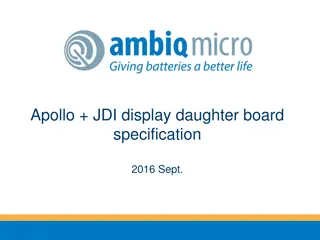Apixaban for Thromboembolic Prophylaxis in COVID-19: APOLLO Trial Results
Patients with COVID-19 are at higher risk of thrombotic events, and antithrombotic regimens have shown varied results in previous trials. The APOLLO trial investigated the use of apixaban for prophylaxis in outpatients with additional risk factors. Results indicated that low-dose apixaban did not significantly improve outcomes compared to placebo at 30 days. The study was multicenter, double-blinded, and randomized, enrolling 1000 patients. Funding sources included Pfizer, with no influence on study conduct.
Download Presentation

Please find below an Image/Link to download the presentation.
The content on the website is provided AS IS for your information and personal use only. It may not be sold, licensed, or shared on other websites without obtaining consent from the author.If you encounter any issues during the download, it is possible that the publisher has removed the file from their server.
You are allowed to download the files provided on this website for personal or commercial use, subject to the condition that they are used lawfully. All files are the property of their respective owners.
The content on the website is provided AS IS for your information and personal use only. It may not be sold, licensed, or shared on other websites without obtaining consent from the author.
E N D
Presentation Transcript
Apixaban for PrOphyLaxis of thromboemboLic Outcomes in COVID-19 The Primary Results of the APOLLO Randomized Trial Renato D. Lopes, Pedro Gabriel Melo de Barros e Silva, Ariane Vieira Scarlatelli Macedo, Bruna Bronhara, Alexandre B. Cavalcanti, Regis G. Rosa, Ot vio Berwanger, Viviane C. Veiga, Luciano C.P. Azevedo, Murillo O. Antunes, Ot vio Celso Eluf Gebara, Eduardo Ramacciotti, Christopher B. Granger, John H. Alexander, Alvaro Avezum, on behalf of the APOLLO Investigators
Declaration of Interest The APOLLO trial was was an investigator-initiated study led by the Brazilian Clinical Research Institute (BCRI) and the COALITION COVID-19 with financial support from Pfizer. The funding sources had no role in the study conduct, analysis, interpretation of data, or decision to publish the results Research grants or contracts from Amgen, Bristol Myers Squibb, GlaxoSmithKline, Medtronic, Pfizer, Sanofi-Aventis Funding for educational activities or lectures from Pfizer, Bristol Myers Squibb, Novo Nordisk, AstraZeneca Funding for consulting or other services from Bayer, Boehringer Ingelheim, Bristol Myers Squibb, Novo Nordisk, AstraZeneca
Background Patients with coronavirus disease 2019 (COVID-19) have a higher risk of thrombotic events. Randomized trials have shown inconsistent results with different antithrombotic regimens in hospitalized patients. INSPIRATION (n=562): no clinical benefit (composite of venous or arterial thrombosis, treatment with extracorporeal membrane oxygenation, or mortality) AND potentially more complications (e.g. severe thrombocytopenia) in the intermediate-dose group compared with standard prophylaxis in ICU patients. ACTION (n=615): no clinical benefit (hierarchical analysis of time to death, duration of hospitalization, or duration of supplemental oxygen) AND more bleeding in the full-dose group compared with standard prophylaxis. ATTACC, ACTIV-4a, and REMAP-CAP (N=1098 patients critically ill): The trial was stopped due to futility. ATTACC, ACTIV-4a, and REMAP-CAP (n=2219 noncritically Ill patients): Stopped early for superiority (organ support free days). Observational studies suggest a potential benefit of anticoagulation in the outpatient setting, however, there is limited randomized evidence to assess the efficacy and safety of anticoagulation in the early phase of COVID-19. INSPIRATION Investigators. JAMA. 2021 Apr 27;325(16):1620-1630. Lopes RD, et al. Lancet. 2021 Jun 12;397(10291):2253-2263. The ATTACC, ACTIV-4a, and REMAP-CAP Investigators. N Engl J Med 2021; 385(9):777-789. The ATTACC, ACTIV-4a, and REMAP-CAP Investigators. N Engl J Med 2021; 385(9):790-802.
Study Hypotheses In outpatients with confirmed COVID-19 and additional risk factors for complication: Low dose apixaban improves the number of days alive and out of the hospital at 30 days compared with placebo.
Trial Design Multicenter, double-blinded, randomized clinical trial RANDOMIZED N: 1000 patients MAIN EXCLUSION CRITERIA Formal indication for anticoagulation Contraindications to apixaban Patients at high risk for bleeding KEY INCLUSION CRITERIA Patients aged 18 years Outpatient setting with a confirmed diagnosis of COVID-19 and symptoms up to 10 days Additional risk factors (D dimer 2 x ULN, CRP 10 mg/L or 2 risk factors) Apixaban 2.5 mg bid for 30 days PLACEBO PRIMARY OUTCOME Days alive and out of the hospital at 30 days
Trial Organization EXECUTIVE COMMITTEE OF APOLLO TRIAL Renato D. Lopes (Chair) Ariane Vieira Scarlatelli Macedo (Brazil) Lilian Mazza Barbosa (Brazil) Lucas Damiani (Brazil) Pedro Gabriel Melo de Barros e Silva (Brazil) Eduardo Ramacciotti (Brazil) Christopher B. Granger (USA) John H. Alexander (USA) DATA SAFETY MONITORING BOARD Mark Crowther (Chair) Leticia Kawano Dourado (Member) Karen Pieper (Statistician) Athos Damiani (BCRI - Statistician) CLINICAL EVENTS CLASSIFICATION (CEC) COMMITTEE Brazilian Clinical Research Institute (BCRI) ACADEMIC COORDINATING CENTER Brazilian Clinical Research Institute (BCRI) EXECUTIVE COMMITTEE OF COALITION COVID-19 Renato D. Lopes Alexandre Biasi Alvaro Avezum Flavia Machado Otavio Berwanger R gis Rosa Viviane Cordeiro Veiga Luciano Azevedo SPONSOR COALITION COVID-19 Brazil FUNDING Pfizer S.A.* *Unrestricted research grant from Pfizer S.A., which was not involved in design, conduct or interpretation of the study
Primary Outcome Number of days alive and outside of the hospital through 30 days This endpoint represents the follow-up time (30 days) minus days outside hospital/emergency department and for those who die, the days between death and 30 days. Lopes RD et al. Am Heart J 2020;226:1-10 Fanaroff AC et al. Circ-cardiovasc Qual 2018;11:e004755.
Statistical Analysis The primary analysis followed the intention-to-treat principle. The primary outcome was analyzed comparing means of days alive and out of the hospital or emergency department (DAOH) with generalized additive models assuming beta-binomial distribution in 30 days. Mean differences were presented with their 95% CI and p-values. Binary secondary outcomes were assessed with logistic regression and odds ratio were presented with their respective 95% CI and p-values. Lopes RD et al. Am Heart J 2020;226:1-10
Study Diagram 624 patients with confirmed COVID-19 assessed for eligibility 42 Without COVID-19 confirmation 37 Negative test 5 Not tested 4 > 10 days of symptoms 4 Patient needed hospitalization 8 Pregnant 137 Without 2 risk factors, with normal D-dimer and/or C- reactive protein 18 Declined to participate 411 41% of initial sample size 204 were assigned to the placebo group 207 were assigned to the apixaban group 204 completed 30 days alive 0 patients died 3 patients withdrew informed consent 203 completed 30 days alive 1 patient died 0 patients withdrew informed consent 100% complete 30-day follow-up 100% complete 30-day follow-up
Study Interruption The trial was stopped prematurely due to slower than expected recruitment and low overall event rates. DAOH was expected to be a mean of 27.0 days (SD=6); however only 6% needed hospitalization or visited the emergency department leading to a 29.5 DAOH (SD=2.0). Lopes RD et al. Am Heart J 2020;226:1-10 Fanaroff AC et al. Circ-cardiovasc Qual 2018;11:e004755.
Baseline Characteristics Apixaban (n=207) Placebo (n=204) Total (n = 659) 44.3 14.8 (n = 207) 43.7 13.1 (n = 204) 44.0 14.0 (n = 411) Age, mean SD, yrs 120/207 (58.0%) 120/204 (58.8%) 240/411 (58.4%) Women, n (%) 28.7 5.4 (n = 207) 28.8 5.6 (n = 204) 28.7 5.5 (n = 411) BMI, mean SD, kg/m2 6.0 [4.0, 8.0] (n = 207) 6.0 [4.0, 8.0] (n = 204) 6.0 [4.0, 8.0] (n = 411) Symptom onset [interquartile range] COVID-19 VACCINE 180/206 (87.4%) 174/204 (85.3%) 354/410 (86.3%) At lease 1 dose NUMBER OF DOSES 20/180 (11.1%) 13/174 (7.5%) 33/354 (9.3%) 1 dose 156/180 (86.7%) 157/174 (90.2%) 313/354 (88.4%) 2 doses 4/180 (2.2%) 4/174 (2.3%) 8/354 (2.3%) 3 doses
Baseline Characteristics Apixaban (n=207) Placebo (n=204) Total (n = 411) RISK FACTORS 21/207 (10.1%) 23/204 (11.3%) 44/411 (10.7%) D dimer above limit, n(%) 163/207 (78.7%) 15/207 (85.0%) 69/207 (33.3%) 1/207 (0.5%) 24/207 (11.6%) 6/207 (2.9%) 0/207 (0.0%) 2/207 (1.0%) 5/207 (2.4%) 2/207 (1.0%) 81/207 (39.1%) 164/204 (80.4%) 17/204 (85.3%) 60/204 (29.4%) 0/204 (0.0%) 25/204 (12.3%) 7/204 (3.4%) 0/204 (0.0%) 3/204 (1.5%) 3/204 (1.5%) 3/204 (1.5%) 77/204 (37.7%) 327/411 (79.6%) 32/411 (82.2%) 129/411 (31.4%) 1/411 (0.2%) 49/411 (11.9%) 13/411 (3.2%) 0/411 (0.0%) 5/411 (1.2%) 8/411 (1.9%) 5/411 (1.2%) 158/411 (38.4%) C-reactiveprotein > 10 mg/L, n(%) C-reactiveprotein above limit, n(%) Hypertension, n (%) Heart failure, n (%) Diabetes, n (%) Asthma, n (%) Known kidney disease, n (%) History of VTE, n (%) Coronary artery disease, n (%) History of VTE BMI 30
Primary Outcome: Days Alive and Out of the Hospital at 30 Days 100% 194/204 (95.1%) 190/204 (93.1%) Patients not hospitalized 80% Placebo mean days SD:29.5 2.4 60% Apixaban mean days SD: 29.6 1.6 40% Mean difference (95%CI): 0.18 [-0.22 - 0.58] 20% 0% Placebo Apixaban
Clinical Status at 30 Days Hospitalized patients within 30 days n/N (%) Apixaban 10/204 (4.9%) Placebo 14/204 (6.9%) Odds Ratio [IC 95%] 0.70 [0.30 to 1.61]
Secondary Endpoints Apixaban (n=207) Placebo (n=204) Odds Ratio RISK FACTORS Hospitalization 10/204 (4.9%) 14/204 (6.9%) 0.70 [0.30 - 1.61] Due to bleeding 0/204 (0.0%) 0/204 (0.0%) - Due to cardiovascular/pulmonary causes 9/204 (4.4%) 14/204 (6.9%) 0.63 [0.26 - 1.48] Due to cardiovascular causes 1/204 (0.5%) 0/204 (0.0%) - Due to pulmonary causes 8/204 (3.9%) 14/204 (6.9%) 0.55 [0.23 -1.35] Other 1/204 (0.5%) 0/204 (0.0%) - Composite endpoint of arterial and venous thrombosis 0/204 (0.0%) 0/204 (0.0%) - Death 0/204 (0.0%) 1/204 (0.5%) - Cardiovascular death 0/204 (0.0%) 0/204 (0.0%) - Intrahospital death 0/204 (0.0%) 1/204 (0.5%) - Any bleeding 4/204 (2.0%) 2/204 (1.0%) 2.02 [0.37 - 11.15]
Conclusion In symptomatic, but clinically stable outpatients with COVID-19 and additional risk factors for thrombotic complications, treatment with apixaban 2.5 mg twice daily compared with placebo did not improve the number of days alive and out of the hospital. No major bleeding was observed in the trial population.
Clinical Implication Our results do not support the routine use of low-dose apixaban for outpatients COVID-19.
Acknowledgement Thank you to the BCRI team, investigators, study coordinators, sponsor, and study participants who made the APOLLO trial possible.



![❤[PDF]⚡ Apollo Mission Control: The Making of a National Historic Landmark (Spr](/thumb/21551/pdf-apollo-mission-control-the-making-of-a-national-historic-landmark-spr.jpg)
![❤Book⚡[PDF]✔ The Apollo Guidance Computer: Architecture and Operation (Springer](/thumb/21611/book-pdf-the-apollo-guidance-computer-architecture-and-operation-springer.jpg)


















